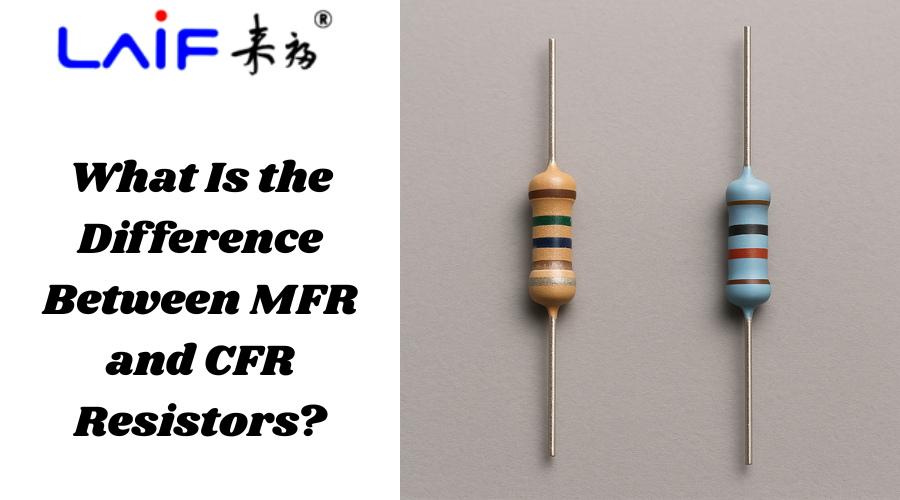
Resistors are electrical components that are essential in an electronic circuit since it controls the rate of current flow and levels of voltage. Metal Film Resistors (MFR) and Carbon Film Resistors (CFR) are fixed resistors; both have different properties between them. Though both perform the same primary function, there is a difference concerning material, precision, stability, and performance. MFR resistors give higher accuracy with lower noise and are suitable for precision applications, while CFR resistors are cheaper and best suited for general-purpose and high power. Therefore, one needs to understand these differences to select a resistor based on circuit needs and the environmental conditions.
In the making of carbon film resistors (CFR), carbon is deposited on a magnetic rod or ceramic tube and the formation of carbon film crystals on its surface. The thickness of the carbon film can be regulated with notch grooving so as to achieve the desired resistance value. Sealing is made stronger with epoxy applied to its surface.
The resistance value in color ring carbon film resistors ranges from 1Ω-10MΩ, with rated powers of 0.125W, 0.25W, 0.5W, and 1W, etc., and tolerances of ±10%, ±5%, and ±2%. Such carbon film resistors are typically larger in size and are often used in cheap electronic products, such as mobile phone chargers and computer power supplies.
The metal film resistor (MFR) is made with a metal film which is evaporated or infiltrated to the surface of a ceramic pipe form. It is set on the surface of the white ceramic, where greater precision can be obtained by cutting. Metal film resistors are characterized by their high accuracy and small size and high stability at a somewhat elevated price. Thus usually are used in wireless electronic devices as metal film resistors will need to be military grade for the high precision features.
In comparison to CFR resistors, which are carbon resistors, MFR resistors are manufactured by using a metal film deposited by a layer of thin metal, that is, nickel-chromium or tin oxide, on a ceramic substrate, and creating the resistive element by etching a spiral form into the metal layer. On the other hand, for CFR, the ceramic substrate is applied with a thin film of carbon, and the resistance is controlled by trimming the carbon layer helical, that is the procedure for manufacturing carbon film resistors.
Precision-wise and tolerances-wise, MFR resistors can exhibit a rather low tolerance, typically ranging between ±0.1%- ±1%. They are a treat for all applications that require extremely high precision. In contrast, CFR resistors exhibit a much bigger tolerance range, being between ±2% and ±10%. That means the real value of the effective resistance is allowed to stray much farther from the nominal value, which makes them less suitable for precision applications.
Another major difference lies in the temperature stability. MFR resistors have the lowest temperature coefficient, usually between +5 to +50 ppm/°C, it indicates that resistance remains nearly unchanged with the change in temperature. On the contrary, CFR has a high-temperature coefficient, in the range of ±200 to ±1000 ppm/°C, producing instability to the different temperature conditions.
The metal film has a very even structure and thus creates noise that is lower than that produced by other types of resistors. This makes MFRs superior in audio and high-frequency applications that need least signal loss. In turn, CFRs generate rather more noise than other resistors because of the granular nature of the carbon film and are therefore used where the integrity of the signal is not critically affected.
Another parameter which distinguishes these two types is the power rating. The MFRs have a relatively small power rating as they always range from 1/8 W to 2 W since they are meant for precision rather than high power dissipation. Most of the time, power ratings of these kind of resistors can be quite high, more than 5 W, thus suitable for applications where high heat dissipation is needed; the reason why it is also called CFR resistor.
Unlike the MFR, which is considered superior in precision applications, the CFR can withstand higher voltages and surge currents, thus making it very suitable for application in power supplies and circuits subjected to transient voltages. The MFR has less voltage withstand capability and is not applicable in circuits that experience high-voltage spikes frequently.
Price is yet another deciding factor. MFR resistors cost more because of their higher precision, stability, and low-noise attributes. The cheaper variety, CFR resistors, finds wide applications in general purposes where a high degree of precision is not a prime requirement.
MFR resistors have low-noise precision for stable applications such as instrumentation, audio equipment, and high-frequency circuits. CFR resistors are intended primarily for general-use, higher power, and high-voltage requirements where precision is not so critical. Making a choice between the two of them means carefully considering the